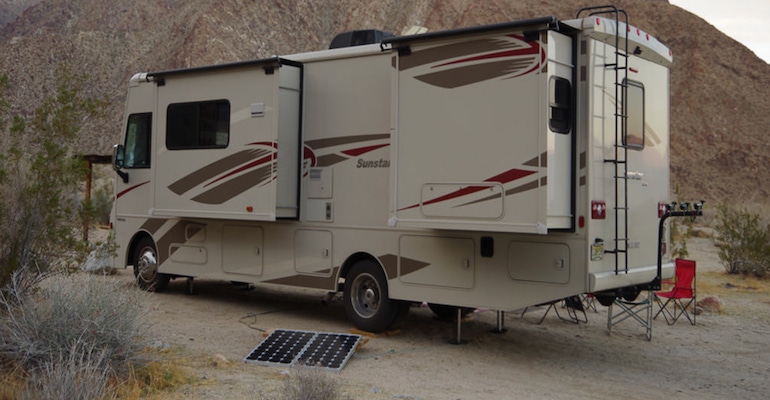As long as you are willing to skip a few comforts of home while camping, solar panels can be used to power your RV—cleanly and quietly.
November 10, 2021

Camping with a motorhome allows you to bring nearly all of the comforts of home with you. But many of those comforts require power. If you are “camping” at a location that allows you to plug into the electric grid (shore power) that’s not a problem. If you are away from a convenient source of electricity the answer has traditionally been gasoline, diesel, or natural gas-powered generator to supply electricity. These generators produce noise and air pollution—two of the things you are trying to get away from by going camping.
There are alternatives. The most common is to use an array of photovoltaic (PV) solar panels to produce electricity that is stored in batteries. While this used to be a very expensive option, the price of both solar panels and advanced battery energy storage has been decreasing steadily for the past decade making the solar option cost-effective.
It would seem that the obvious place to mount the solar panels would be on the flat roof of your RV or motorhome. There are pluses and minuses to this location—the panels are in place and ready to go whenever the sun is shining, they can be permanently attached to the charge controller and battery storage system and don’t require any additional activity by the owner to charge the batteries.
The downside to placing the solar panels permanently on the roof of an RV is that to get the greatest amount of charging electricity the vehicle must be parked directly in the sun, which heats the interior and may not be as pleasant as parking in a shady spot. In addition, the solar panels that are on the roof are constantly exposed to weather and road hazards which can include damaging hail or being scraped and damaged by tree branches. Mounting the solar panels permanently on the roof usually requires drilling holes into the roof, which can cause water leaks.
An alternative is to use portable folding solar panels that can be deployed to charge the batteries when the RV is stopped for an extended period of time. Several companies produce this type of product including Renogy that makes suitcase-style folding solar panels with charge controllers that can connect to the energy storage batteries in an RV within minutes. Another company, Acopower, has a portable solar panel that also has USB outlets to charge personal electronics like phones and laptops.
The portable solar panels can be taken out and set in direct sunlight, using their built-in stands to angle the panels to receive the maximum amount of solar energy. When not in use they can be folded and stored inside the RV where they are protected from damage. Portable folding solar panels can also be moved from one RV to another when you get a new RV and can also be used at home for emergency power during a power outage.
Solar power for an RV won’t replace shore power—running an air conditioner or other power-hungry appliances from battery power isn’t practical. Running a few lights, a small refrigerator, and a laptop certainly is possible. Maybe camping doesn’t have to always include every comfort of home.
Kevin Clemens is a Senior Editor with Battery Technology.
About the Author(s)
You May Also Like





